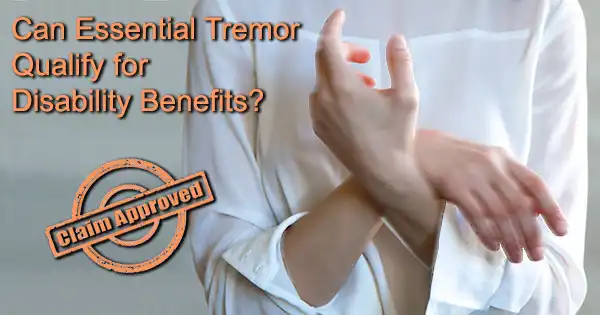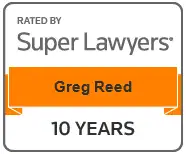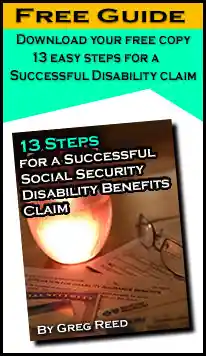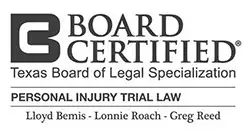Can Essential Tremor qualify for Disability Benefits?
What does the Social Security Administration say about qualifying for disability while suffering from the effects of Essential Tremor?
Author Attorney Lloyd Bemis:
Updated: 10/10/2024
Summary: Can I get disability benefits if I am suffering from the effects of Essential Tremor?
First you must meet the SSA’s financial requirement: You must have worked long enough, recently enough, and not made over a predetermined level of income.
Second you must meet the medical requirements:
In order to qualify for Social Security Disability Income, you must be able to show (1) that your tremor has prevented you, or is expected to prevent you, from working for at least 12 consecutive months, and (2) that you don’t have the ability to function at a sedentary job or that your tremor fulfills the requirements for Social Security’s impairment listing for Parkinson’s disease.
Essential tremor (or “ET”) is a neurological disorder that causes involuntary shaking in an area of the body. Also known as familial tremor or hereditary tremor, the hands and forearms are most often affected, but tremors can also occur in the head, face, tongue, neck and torso. Essential tremor is one of the most common neurological disorders in adults, but can begin at any age and affects approximately seven million people in the United States.

Though the SSA does not list essential tremor specifically it does acknowledge the effects of the disorder. You must show that you don’t have the ability to function at a sedentary job.
A tremor is an involuntary, rhythmic movement of a body part.
Tremors may be constant, frequent, or occasional and minor or severe. Both sides of the body are usually affected, but may not be equally affected. Most people with ET experience tremors while performing a daily task, such as tying their shoes or pouring a drink. These are called action tremors. Tremors can also occur while not moving; for example, sitting in chair with an arm resting. These tremors are known as tremors at rest.
Essential Tremor and Qualifying for Disability Benefits.
There is no doubt that essential tremor can severely impact an individual’s social interactions and daily activities.
Eating, drinking, writing, and dressing may become difficult and a person may no longer be able to function at their job. Though the Social Security Administration does not list essential tremor specifically as an impairment in its Blue Book, it does acknowledge the effects of the disorder under Section 11.00 Neurological:
We evaluate epilepsy, amyotrophic lateral sclerosis, coma or persistent vegetative state (PVS), and neurological disorders that cause disorganization of motor function, bulbar and neuromuscular dysfunction, communication impairment, or a combination of limitations in physical and mental functioning such as early-onset Alzheimer’s disease. We evaluate neurological disorders that may manifest in a combination of limitations in physical and mental functioning.
Disorganization of motor function means interference, due to your neurological disorder, with movement of two extremities; i.e., the lower extremities, or upper extremities (including fingers, wrists, hands, arms, and shoulders). By two extremities we mean both lower extremities, or both upper extremities, or one upper extremity and one lower extremity. All listings in this body system, except for 11.02 (Epilepsy), 11.10 (Amyotrophic lateral sclerosis), and 11.20 (Coma and persistent vegetative state), include criteria for disorganization of motor function that results in an extreme limitation in your ability to:
- Stand up from a seated position; or
- Balance while standing or walking; or
- Use the upper extremities (including fingers, wrists, hands, arms, and shoulders).
In order to qualify for Social Security Disability Income, you must be able to show (1) that your tremor has prevented you, or is expected to prevent you, from working for at least 12 consecutive months, and (2) that you don’t have the ability to function at a sedentary job or that your tremor fulfills the requirements for Social Security’s impairment listing for Parkinson’s disease.
In considering your case, Social Security will perform a Residual Functioning Capacity assessment to evaluate how tremors affect your ability to perform strength-related tasks and your non-exertional (non-strength) impairments. Strength related tasks include lifting, carrying, walking and standing. Non-exertional impairments include difficulty using the hands and fingers for handling objects, difficulty stooping and crouching, and difficulty caused by anxiety, depression or nervousness. If you have the ability to perform a job while sitting, it’s likely that your claim for SSDI will be denied. If the SSA concludes that tremors prevent you from performing a full range of physical activities required by a sedentary job, you may be approved. In submitting your claim, it is important to include – in writing in your medical records – any and all non-exertional limitations you may have where strength-related abilities are not affected by tremors.
If you have tremors in two extremities, such as both hands, and can provide evidence that your symptoms and limitations are as severe as Parkinson’s disease or another similar medical condition, you may meet the requirements of that impairment and be approved.
For example, if you are unable to control the movement in both hands or arms even with three months treatment.
In order to qualify for Social Security Disability, you will need to satisfy a few specific requirements in two categories as determined by the Social Security Administration.
The first category is the Work Requirements which has two tests.
- The Duration of Work test. Whether you have worked long enough to be covered under SSDI.
- The Current Work Test. Whether you worked recently enough for the work to actually count toward coverage.
The second category is the Medical Eligibility Requirement.
- Are you working? Your disability must be “total”.
- Is your medical condition severe? Your disability must be “severe” enough to interfere with your ability to perform basic work-related activities, such as walking, sitting, and remembering.
- Is your medical condition on the List of Impairments? The SSA has a “List of Impairments” that automatically qualify as “severe” disabilities. If your disease is not listed this does not mean you cannot get disability, it means you must prove you cannot maintain employment due to your limitations.
- Can you do the work you did before? SSDI rules look at whether your medical condition prevents you from doing the work you did prior to developing the condition.
- Can you do any other type of work? If you cannot do your prior work, an evaluation is made as to whether you can perform any other kind of work.
More details can be found on our Qualifying for Disability page.
Disability benefits are an important source of income for those who are unable to work. If you not able to work due to accident or illness, you may be eligible for Social Security Disability or Long Term Disability benefits. If you have applied for benefits and been denied, contact the attorneys at Bemis, Roach and Reed for a free consultation. Call 512-454-4000 and get help NOW.
Parkinson’s Disease and Disability Benefits
Can Peripheral Neuropathy qualify me for Disability Benefits?
Seizure Disorders and Qualifying for Disability Benefits


Your Free Initial Consultation
Call now:
At Bemis, Roach and Reed, if we can't help you, we will try to find the right attorneys for you.
We offer each of our prospective clients a free no obligation one hour phone or office consultation to see if we can help you and if you are comfortable with us. We know how difficult a time like this can be and how hard the decisions are. If we can be of assistance to you and help you find a solution to your issue we will, even if that means referring you to another attorney.
Let's get you Started:
If you could provide us with some basic information about your claim we will get right back with you with a free case evaluation and schedule your Free Consultation Today.
You can also email us at: contact@brrlaw.com
Kind Words from Our Clients
“The attorneys and staff at Bemis, Roach & Reed have provided me and my husband, Jeff, with stellar advice, care, and service. They made navigating the SSDI process easy, painless, and as timely as possible. During this difficult time in our lives it was a tremendous relief to know they were on our side and keeping us updated on next steps and timelines. We also had questions about my husband’s long term disability insurance and they helped us get those questions answered and resolved without any additional fee. I highly recommend Bemis, Roach & Reed.” – Kelli G
“I needed a lawyer for my case and had googled best lawyers. They came up first on my list and decided to give them a call. From the moment I called I knew I chose the right people. They said they would fight for me and fight they did. They knew what they were doing and kept good communication throughout the process. If you need someone that will listen, understand, and fight then these are the people. HIGHLY RECOMMEND.” – Marcel L.
“I’ve had a great experience working with Bemis, Roach & Reed for my disability case. I spent two years fighting on my own, until I was informed to look for a disability lawyer. Right away, sending in questions was a breeze, and from the moment my case was accepted, everything became a major weight off my shoulders. My newest appeal was filed for me, my medical records and case history sorted for me, and I could finally focus on my appointments and treatment with a little less worry. Everything was explained to me in a way that made sense, the process was set out in an easy to understand way. And, just like that, at the beginning of July 2023, my claim was accepted!” – Sunshinemutt






